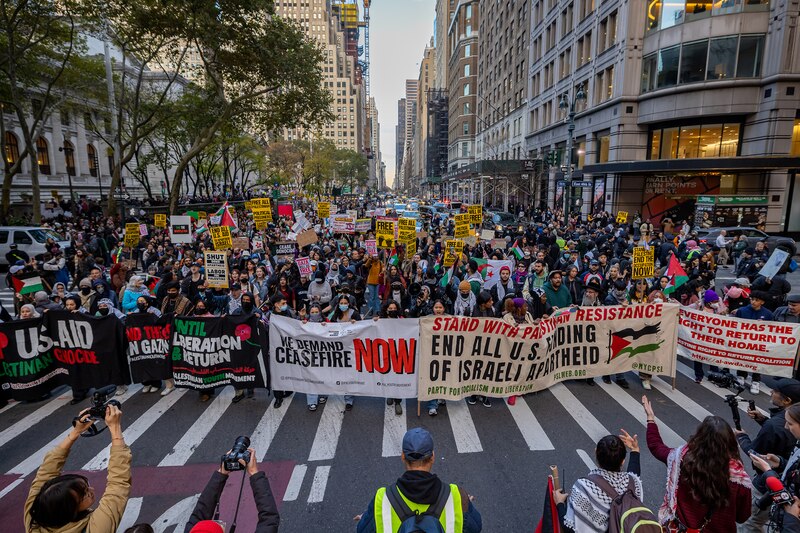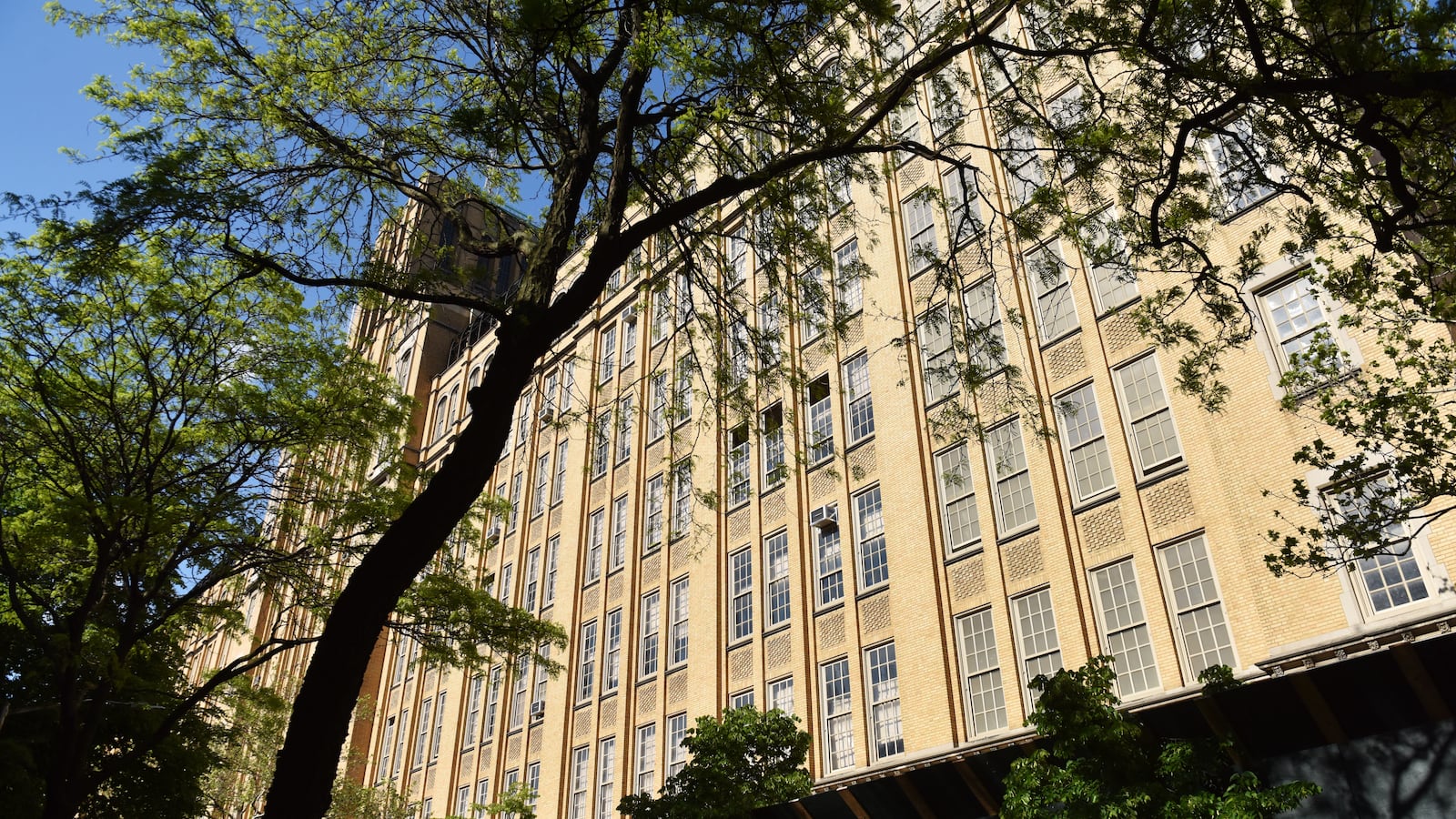For many New York City teenagers, the violence that’s unfurled thousands of miles away in Israel and the Gaza Strip over the past seven weeks has felt startlingly close to home.
Both Muslim and Jewish students told Chalkbeat they’ve noticed an uptick in hurtful and derogatory comments from classmates at school or over social media, echoing a recent state review that found Islamophobic and antisemitic rhetoric have each jumped by more than 400% on social media since Hamas’s Oct. 7 attack on Israel and the country’s retaliation.
Students, meanwhile, are glued to their phones. They’re trying to keep up with an endless stream of often-graphic social media content about the ongoing war while attempting to sift through a barrage of conflicting information and viewpoints, they said.
It’s “scary … to be teenagers and dealing with antisemitism and Islamophobia,” one Brooklyn high school student said, adding that they were “grappling with how to feel about this horrible thing that’s going on that we don’t have any control over.”
School can feel like one of the few safe places to make sense of the Israel-Hamas war, learn about the historical underpinnings of the crisis, and try in some small way to take action, teens said.
Hamas militants killed an estimated 1,200 Israelis and took another 240 hostage, and Israel’s subsequent bombardment of Gaza has killed at least 11,000 Palestinians, including thousands of children.
City schools, however, are taking divergent approaches to navigating conversations about the war, and in some cases largely avoiding it, according to interviews with educators and students at six high schools, most of whom spoke only on the condition of anonymity because of the sensitivity of the issue.
At some high schools — particularly large ones — pressure to keep up with fast-paced curriculums, fears about further inflaming tensions, and caution about steering clear of political landmines, especially after a warning from schools Chancellor David Banks to keep personal views out of the classroom, have made it difficult to create dedicated spaces to talk about the war, educators and students told Chalkbeat.
“It’s kind of like an elephant in the room for many students,” said a senior at Midwood High School in Brooklyn. “There haven’t been any discussions in classes.”
“It’s very sensitive … and no one wants to get written up or lose their job,” added a Brooklyn Tech staffer. “No one wants to say anything because no one wants to get into trouble.”
The Education Department provided school leaders with a resource guide to “help them work with their staff to support instruction based on facts about the war in the Middle East as well as resources on supporting students during this difficult time,” spokesperson Chyann Tull said.
Banks’s warning about political speech was only meant to reiterate existing city rules and to encourage teachers to remain objective when discussing charged issues, according to officials.
At one Brooklyn high school, students frustrated by the lack of opportunities to talk about the conflict during the school day organized an after-school meeting, supervised by teachers at school, between Jewish and Muslim student groups. They plan to invite expert speakers to give students more background, according to a student who helped organize the events and spoke anonymously for fear of retaliation.
“Having these conversations is really important, and if we can have them in a setting that’s monitored and we have access to concrete information, that’s really helpful,” the student said. “It’s something that 16-year-olds should not have to organize … but I think teachers are scared to be talking about it.”
Some schools and teachers wade into difficult conversations
That’s not to say there aren’t educators and schools across the city wading into difficult conversations.
Kate Cook, a Spanish and senior advisory teacher at Brooklyn Tech, doesn’t normally teach about Israel and the Palestinian territories, and she was nervous about upsetting kids and doing justice to the complex history of the conflict. In each of her classes, she knew she’d likely have multiple students with ties to the region, heightening the stakes. But she decided the risks of avoiding the discussion outweighed the potential pitfalls of diving into it.
“If teachers don’t address it, it sends the message it’s not important and we don’t care about it,” she said.
Cook started with several informal check-ins shortly after Oct. 7 and again after the Israeli bombardment of Gaza began, and asked students to check in on both their Jewish and Muslim classmates. Several weeks later, she led a lesson meant to help students think through all of the ways they process news about the war – intellectually, emotionally, and as a matter of conscience.
There were challenging moments, including a spirited debate between a student forcefully arguing “Hamas needs to be eradicated” and another saying you “can’t ignore” decades of occupation, Cook said.
But she knew it was the right decision when the mother of one of her students approached her at parent-teacher conferences to thank her. The girl had family in Israel and “came home in tears because she was so happy” Cook had checked in with her students, the mom said.
“Particularly at a big school, we can often underestimate our impact as teachers,” Cook said. “But when something big happens in the world, we need to say something.”
Other educators who’ve led classroom lessons about the conflict said they prompted valuable discussions about the relative advantages of social and mainstream media.
Teachers said they tried to help students approach social media more skeptically and spot misinformation without dismissing their arguments that social media has galvanized young people and made information accessible to them in a way mass media hasn’t.
“With the mass media, you are fed information, but on social media, you get to contribute to the message,” one Brooklyn Tech teacher recalled a student saying.
At several smaller schools, teachers have organized optional “teach-ins” during lunch periods and after school for students who want more background on the conflict.
“It was very informative and it didn’t try to force a stance and gave students a chance to make their own conclusions,” said Alexander Calafiura, a senior at East Side Community High School in Manhattan who attended one such session to get a better factual understanding of the conflict. (Calafiura is currently a Student Voices fellow at Chalkbeat).
Teachers who led lessons on the conflict said they were acutely aware that it’s emotional for students and took pains to keep their classrooms feeling safe.
One Brooklyn Tech teacher said he had students frequently flash “thumbs-up” signs to each other to indicate they were OK continuing the lesson. Sari Beth Rosenberg, a history teacher at the High School for Environmental Studies in Manhattan, started her lesson by asking students to agree on the shared principle that all death is bad.
“I think you’re more likely to have a civil discourse if you start it off by framing it as ‘what do we agree on,’” she said.

Politics loom large
The crisis in Israel and Gaza has reignited long-standing debates about the appropriate role of politics in school.
On Nov. 8, the day before a planned student walkout calling for a ceasefire in Gaza, Banks sent the message to all city schools staffers reminding them that city rules bar teachers from expressing their personal political views in class, and that even out-of-school political activity could be out of bounds if it causes a disruption in school.
An Education Department spokesperson said Banks’ warning wasn’t in response to any single event, and Banks told the publication City & State that his intention was not to “silence anybody.”
But critics including New York Civil Liberties Union Executive Director Donna Lieberman argued the missive would “likely have the effect of stifling political discussion both inside the classroom and in the broader community.”
Some educators said that’s indeed come to pass.
“I think it’s egregious that our voices are being censored right now,” said a social worker who spoke on the condition of anonymity. “As faculty and staff we’ve been clearly discouraged from supporting these students.”
Some students and staff argue, moreover, that condemning Hamas’s attack – like Banks did on Oct. 10 – without also acknowledging the ongoing siege of Gaza is itself a political stance.
One Midwood High School student who participated in the Nov. 9 walkout said it “symbolizes our anger towards the Department of Education for their neutral stance and support of the genocide,” a term that has been hotly contested as a way to describe Israel’s siege of Gaza.
At Brooklyn Tech, students sent a letter last week to Principal David Newman criticizing his decision to send an Oct. 10 email acknowledging the Oct. 7 atrocities in Israel without sending a subsequent message acknowledging the deaths in Gaza.
“The Palestinians currently being killed in Gaza at overwhelming rates, most of whom are women and children, are, above all, innocent civilians,” the students wrote. “They, just as innocent Israeli civilians addressed in Mr. Newman’s email, do not deserve death or suffering in any way. They deserve the same amount of respect as the Israeli civilians that Mr. Newman addressed in his email.”
The students also called for more dedicated spaces in school to talk about the conflict, and additional counseling resources.
Newman didn’t respond to a request for comment.
But it’s not only statements about the violence in Gaza that have proven controversial: At the Museum School in Manhattan, administrators declined to include a statement from the Jewish Student Union condemning the Oct. 7 attacks in the school newsletter out of concern it violated Education Department rules on political speech, the school’s newspaper reported.
The debates over political speech also play out on the smaller stage of individual classrooms.
For some teachers, keeping a firewall between personal political beliefs and classroom teaching is critical.
“We shouldn’t be talking about our political beliefs in the classroom, I don’t think that should be controversial,” said Rosenberg, the Manhattan history teacher, adding that teachers’ backgrounds also shouldn’t play a role in how they discuss current and political events.
“Your classroom is not the place to work out your identity issues,” she said.
But other teachers argue it’s not so simple, and that shielding students entirely from their political beliefs and biases is unrealistic and counterproductive.
“If people ask me, I will have separate conversations,” said one Bronx history teacher, who said her students know she is both Jewish and “anti-occupation.”
“I have no problem with people seeing my point of view as one point of view.”
Michael Elsen-Rooney is a reporter for Chalkbeat New York, covering NYC public schools. Contact Michael at melsen-rooney@chalkbeat.org.

